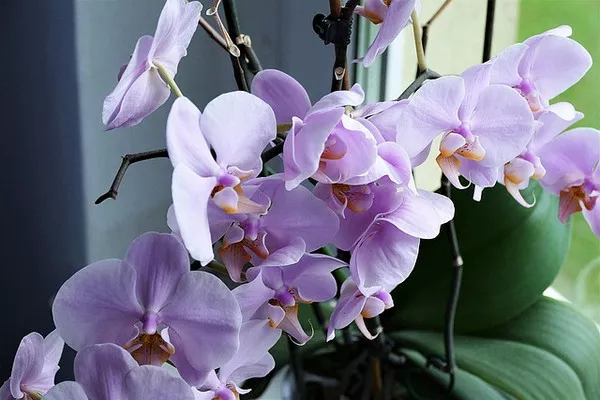Orchids have long captivated the hearts of botanists, horticulturists, and enthusiasts with their extraordinary diversity and breathtaking beauty. Among their many intriguing features, the orchid flower spike stands out as a prominent and essential component of these captivating plants. Orchid flower spikes showcase a remarkable blend of elegance and complexity, serving as the stage upon which the magnificent flowers make their grand entrance. In this article, we will delve into the intricate details of what an orchid flower spike looks like, exploring its anatomy, development, and the diverse array of forms it can take.
Anatomy of an Orchid Flower Spike
An orchid flower spike, also known as an inflorescence, is a specialized stem that arises from the axil of a leaf or at the base of the pseudobulb in mature orchid plants. Unlike the conventional leafy stems found in many other flowering plants, the orchid flower spike has a distinct structure that is adapted to support and display its unique blossoms.
See Also: How to Get Orchids to Reflower: A Comprehensive Overview
The primary components of an orchid flower spike include:
Peduncle: The peduncle is the main stalk of the flower spike. It emerges from the plant and elevates the inflorescence, positioning the flowers for optimal visibility and pollination.
Rachis: The rachis is a central axis that extends from the peduncle. It supports multiple individual flower buds, arranging them in an aesthetically pleasing and often spiraled manner along its length.
Flower Buds: The flower buds are the embryonic structures that eventually develop into fully-fledged orchid flowers. These buds are arranged in a sequential manner along the rachis, with the lower buds typically maturing and opening first.
Bracts: Bracts are modified leaves that subtend the flower buds. They serve as protective coverings for the developing buds and contribute to the overall aesthetic appeal of the flower spike.
Sheath: The sheath is a tubular structure that encloses and protects the developing flower buds. As the buds mature, the sheath often splits or falls away, revealing the emerging flowers.
See Also: A Full Guide: What Happens When Orchids Lose Their Flowers?
Diversity in Orchid Flower Spike Forms
Orchid flower spikes exhibit a remarkable diversity in their forms and arrangements, a testament to the incredible adaptability of these plants. Different orchid species and genera have evolved unique strategies for displaying their flowers, resulting in a variety of flower spike types.
Panicle: This type of inflorescence features a branched arrangement of flower-bearing stems. Panicles are often seen in orchids such as the Dendrobium genus, where multiple flower buds develop along secondary branches, creating a visually striking display.
Raceme: In a raceme, the flower buds are arranged along a single unbranched stem, with each bud developing from the axil of a modified leaf. The raceme is a common flower spike type seen in many orchid species, including the popular Phalaenopsis orchids.
Spur: Some orchids, like the Lady’s Slipper Orchids (Paphiopedilum), develop a unique structure known as a spur. The flower spike extends downward, and the flowers dangle from the tip of the spike, resembling delicate jewels.
Umbel: An umbel inflorescence features flower buds arising from a common point at the tip of the flower spike. This arrangement is observed in orchids like the Oncidium genus, where the flowers radiate outward like the spokes of an umbrella.
Spiral: Certain orchids, such as the Vanilla orchids, produce flower spikes with a spiral arrangement. The flower buds develop in a helical pattern along the spike, creating an alluring visual effect.
Development of an Orchid Flower Spike
The development of an orchid flower spike is a meticulously orchestrated process influenced by various internal and external factors. Orchids are renowned for their sensitivity to environmental cues, which can impact the timing and abundance of flowering.
Initiation: The journey of a flower spike begins with the initiation of flower buds. This process is often triggered by environmental cues such as changes in temperature, light, or humidity. Once initiated, the flower buds start to develop within protective sheaths.
Growth and Elongation: As the flower buds develop, the peduncle and rachis elongate, carrying the developing buds upwards and positioning them for optimal exposure. The growth rate and pattern of the spike can vary significantly between different orchid species.
Bud Maturation: The individual flower buds within the spike mature at different rates, with the lower buds usually opening first. The protective sheaths that envelop the buds may change color or texture as the buds mature, providing visual cues to the impending blossoms.
Flowering: Orchid flowers start to unfurl from the protective sheaths as they reach maturity. The rate of flowering and the duration of bloom depend on the specific orchid species, environmental conditions, and care provided by growers.
Conclusion
The orchid flower spike is a remarkable and multifaceted structure that plays a pivotal role in the captivating allure of orchid plants. With their diverse forms, intricate development, and unparalleled beauty, orchid flower spikes serve as a testament to the marvels of botanical adaptation and evolution. Whether they dangle delicately from spurs, radiate like umbrellas, or spiral gracefully along the rachis, orchid flower spikes continue to captivate the imagination of enthusiasts, reminding us of the boundless wonders found within the world of plants.


